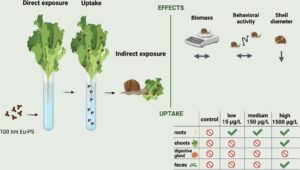

A recent study published by Papillons partners explores how nanoplastics (NPs) move through a terrestrial food chain, specifically from lettuce to snails, and assesses the potential impacts on both organisms. Using europium-doped polystyrene nanoplastics (Eu-PS), researchers uncovered some fascinating insights on the uptake and movement of these particles.
The researchers highlighted the following findings:
– Lettuce uptake: nanoplastics were absorbed mainly by the roots, with smaller amounts reaching the leaves (shoots). Interestingly, while lettuce growth wasn’t severely impacted, the root dry weight increased at higher NP concentrations.
– Transfer to snails: the snails ingested nanoplastics through contaminated lettuce (on which they were fed), but no detectable levels of particles were found in their digestive glands. Instead, NPs were found in their feces, showing that while ingestion occurred, absorption was limited.
– Snail growth: Although the snails’ overall growth (biomass) was not affected, the study observed a decrease in shell diameter in snails after the ingestion of NPs, indicating some physiological effects.
In conclusion, nanoplastics can transfer through the food chain, but their ability to enter tissues appears limited under tested conditions. However, the potential for NPs to move up the food chain, potentially affecting humans, raises important questions for food safety and environmental health.
Read the full study here: https://www.sciencedirect.com/science/article/pii/S0048969724070050?ref=pdf_download&fr=RR-2&rr=8d70d59489b1b703